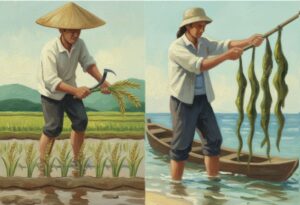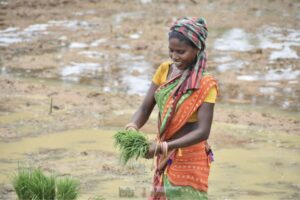
South Korea, officially known as the Republic of Korea, boasts a remarkable rice cultivation history. By adopting high-yielding rice varieties and improved management techniques in the 1970s, South Korea did away with rice imports and turned itself into a self-sufficient rice producer. In 2008, the country produced an average rice yield of 7.3 tons per hectare, feeding around 48 million of its people. Its advances in rice production technology and policies can be attributed to the Rural Development Administration (RDA), its agricultural research and extension arm, and also to its strategic partnership with the International Rice Research Institute (IRRI).
Korea-IRRI partnership
IRRI and RDA began their fruitful partnership in 1964 when they collaborated on a research project that aimed to breed improved rice varieties with cold and salt tolerance, pest and disease resistance, and better grain quality.
In 1968, Korean scientists and plant breeders at IRRI saw the potential of crossing and selecting a tropically grown indica and temperate japonica variety. This spawned the Tong-il variety, a cross of three varieties, namely, IR8, Yukara, and Taichung Native 1. The release of Tong-il and other IR8-derived varieties in 1972 delivered a record yield increase of more than 30%. From then on, the improvement in South Korea’s rice production took off, putting the country on the road to becoming self-sufficient.
 The Rapid Seed Multiplication Program in 1968 also helped accelerate the country’s growth in rice cultivation. Seed materials of newly released rice varieties were propagated at IRRI during the winter season and then returned to South Korea for planting during the summer. By 1995, a total of 1,500 lines had been planted to advance a second generation of rice cultivation not normally feasible during the country’s winter season. This process saves time, labor, and cost for developing rice varieties. More than 120 lines were also produced for small-scale seed increase. At this time, as many as 81 Korean scientists had been seconded to IRRI to supervise the off-season nurseries and seed multiplication.
The Rapid Seed Multiplication Program in 1968 also helped accelerate the country’s growth in rice cultivation. Seed materials of newly released rice varieties were propagated at IRRI during the winter season and then returned to South Korea for planting during the summer. By 1995, a total of 1,500 lines had been planted to advance a second generation of rice cultivation not normally feasible during the country’s winter season. This process saves time, labor, and cost for developing rice varieties. More than 120 lines were also produced for small-scale seed increase. At this time, as many as 81 Korean scientists had been seconded to IRRI to supervise the off-season nurseries and seed multiplication.
Although the release of Tong-il and subsequent varieties promoted Korean rice production, breeding efforts were later directed to problem areas such as tolerance of low temperature and improved grain palatability.
Recognizing the constraints in rice tolerance of low temperature, IRRI and RDA established the Collaborative Project on Rice Cold Tolerance. Together, they conducted experiments in South Korea’s Chuncheon Crop Experiment Station, which allowed for large-scale screening of potential new rice lines that have high tolerance of low temperature.
Exchanging plant genetic materials
To ensure the safe, fair, and free exchange of different types of rice and their characterization and adaptation, South Korea, along with IRRI, got involved in the International Network for the Genetic Evaluation of Rice (INGER). INGER is a 35-year-old partnership among national agricultural research and extension systems of rice-growing countries around the world and international agricultural research centers, such as IRRI.
 INGER provides a global model for the exchange, evaluation, release, and use of genetic resources. The network abides by the International Treaty on Plant Genetic Resources for Food and Agriculture, a treaty that fosters international cooperation and open exchange of genetic resources.
INGER provides a global model for the exchange, evaluation, release, and use of genetic resources. The network abides by the International Treaty on Plant Genetic Resources for Food and Agriculture, a treaty that fosters international cooperation and open exchange of genetic resources.
With the exchange of elite breeding lines, five breeding lines from South Korea were released as varieties in Bhutan, China, and Guatemala, and were planted on a large scale. More than 174 Korean breeding lines and varieties had been used as donor parents in 26 countries for hybridization with local varieties.
In the early 1980s, for instance, Milyang 46 was bred in South Korea and introduced to central China. It became a parent for popular hybrids such as Shanyou 10 and Shanyou 46 between 1980 and 1990. Shanyou 10 was widely planted in China, with a cumulative planted area of more than 2.2 million hectares from 1991 to 2004, whereas Shanyou 46 was planted on more than 3 million hectares from 1991 to 2004.
Developing japonica rice for the tropics
In 1991, IRRI and RDA sought to develop high-quality and high-yielding temperate japonica rice varieties for tropical environments (see Made for the tropics on pages 34-35 of Rice Today Vol. 9, No. 2). Hence, the Germplasm Utilization Value Added project paved the way for scientists to breed elite rice breeding lines that, in turn, provided the base materials for breeding two varieties of temperate japonica rice suited to the tropical conditions of the Philippines—NSIC Rc220 or IRRI 152 and NSIC Rc170 or IRRI 142, now called MS11.
Released in the Philippines in 2008, MS11 is a cross between two Korean varieties, namely, Jinmibeyo, which has high grain quality, and Cheolweon 46, which is highly resistant to pests and diseases in the tropics.
Recently, RDA ceremonially handed over MS11 to farmers for cultivation on the Philippine island of Bohol, at an event marking RDA and IRRI’s long and productive collaboration.
Both IRRI 152 and MS11 were also approved for large-scale planting by the National Seed Industry Council of South Korea. It is expected that local cultivation of these high-quality lines will give farmers higher returns. Consumers as well can enjoy this semiglutinous rice at affordable prices.
________________________________________________________________________________










